1998 CHEVROLET ASTRO spare tire
[x] Cancel search: spare tirePage 257 of 414
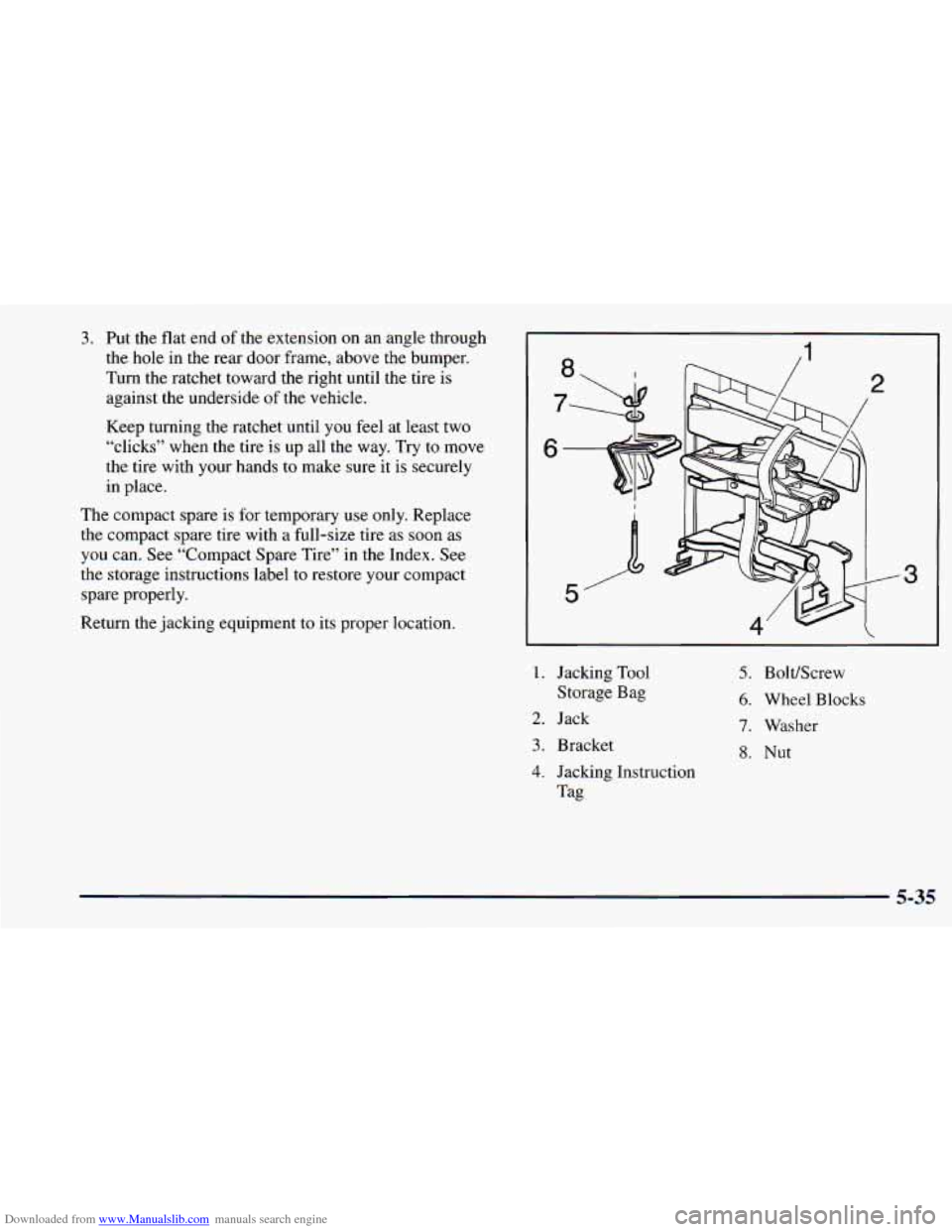
Downloaded from www.Manualslib.com manuals search engine 3. Put the flat end of the extension on an angle through
the hole in the rear door frame, above the bumper.
Turn the ratchet toward the right until the tire is
against the underside of the vehicle.
Keep turning the ratchet until you feel at least two
“clicks” when the tire is up all the way. Try to move
the tire with your hands to make sure it is securely
in place.
The compact spare is for temporary use only. Replace
the compact spare tire with a full-size tire as soon as
you can. See “Compact Spare Tire” in the Index. See
the storage instructions label to restore your compact
spare properly.
Return the jacking equipment to its proper location.
1. Jacking Tool
Storage Bag
2. Jack
3. Bracket
3
5. Bolt/Screw
6. Wheel Blocks
7. Washer
8. Nut
4. Jacking Instruction
Tag
5-35
Page 258 of 414
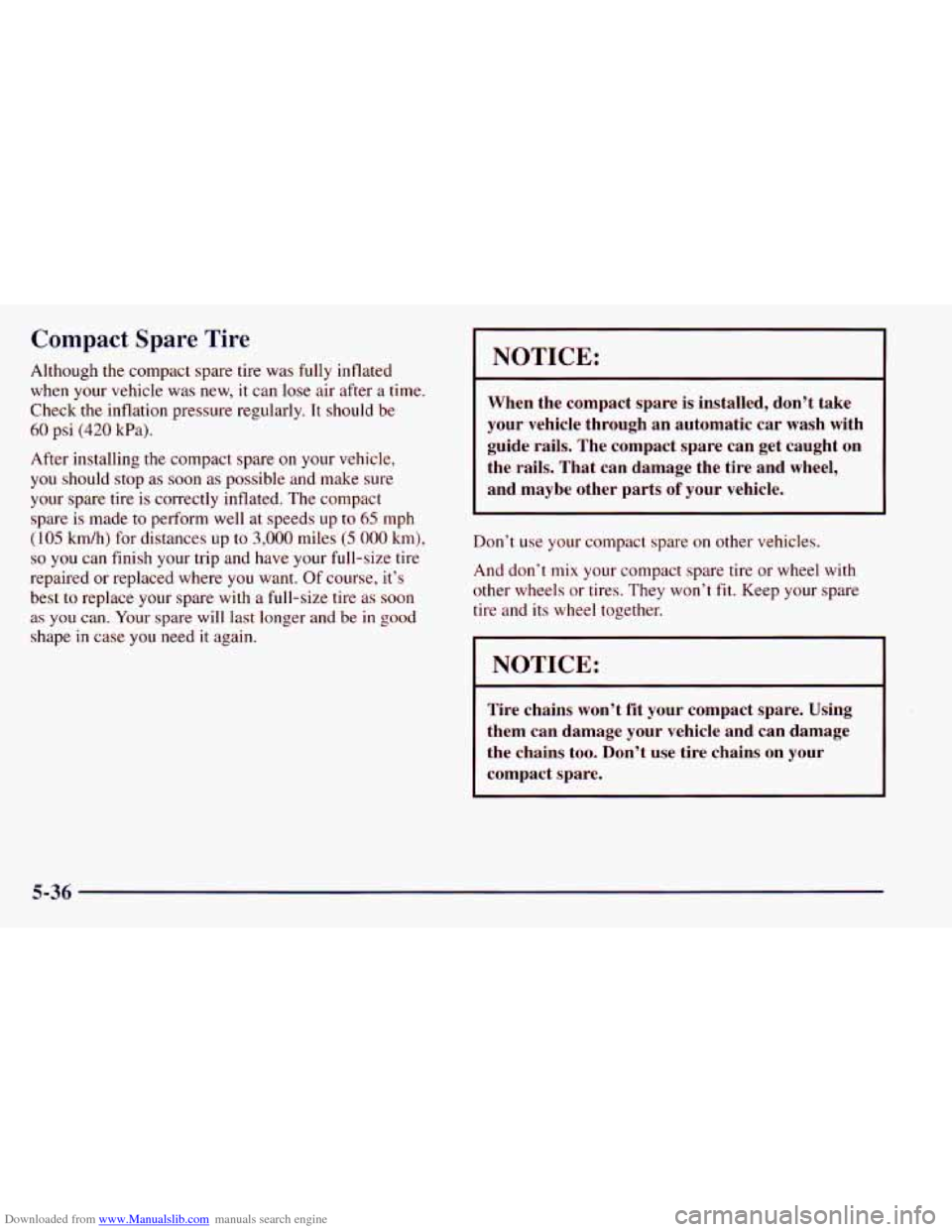
Downloaded from www.Manualslib.com manuals search engine Compact Spare Tire
Although the compact spare tire was fully inflated
when your vehicle was new, it can lose air after a time.
Check the inflation pressure regularly. It should be
60 psi (420 kPa).
After installing the compact spare on your vehicle,
you should stop as soon as possible and make sure
your spare tire
is correctly inflated. The compact
spare is made to perform well at speeds up
to 65 mph
(105 km/h) for distances up to 3,000 miles (5 000 km),
so you can finish your trip and have your full-size tire
repaired or replaced where you want. Of course, it’s
best to replace your spare with a full-size tire as soon
as
you can. Your spare will last longer and be in good
shape in case
you need it again.
NOTICE:
When the compact spare is installed, don’t take
your vehicle through an automatic car wash with
guide rails. The compact spare can get caught on
the rails. That can damage the tire and wheel,
and maybe other parts
of your vehicle.
Don’t use your compact spare on other vehicles.
And don’t mix your compact spare tire or wheel with
other wheels or tires. They won’t fit. Keep your spare
tire and its wheel together.
I NOTICE:
Tire chains won’t fit your compact spare. Using
them can damage your vehicle and can damage
the chains too. Don’t use tire chains on
your
compact spare.
5-36
Page 306 of 414

Downloaded from www.Manualslib.com manuals search engine NOTICE: (Continued)
If your tires have too
much air (overinflation),
you can get the following:
0 Unusual wear
Bad handling
Rough ride
Needless damage from road hazards.
When to Check
Check your tires once a month or more.
Don’t forget your compact spare tire. It should be at
60 psi (420 kPa).
How to Check
Use a good quality pocket-type gage to check tire
pressure. You can’t tell
if your tires are properly inflated
simply by looking at them. Radial tires may look
properly inflated even when they’re underinflated.
Be sure to put the valve caps back on the valve stems.
They help prevent leaks by keeping
out dirt
and moisture.
Tire Inspection and Rotation
Tires should be rotated every 6,000 to 8,000 miles
( 10 000 to 13 000 km). Any time you notice unusual
wear, rotate your tires as soon as possible and check
wheel alignment. Also check for damaged tires or
wheels.
See “When It’s Time for New Tires” and
“Wheel Replacement’’ later in this section for
more information.
The purpose
of regular rotation is to achieve more
uniform wear for all tires on the vehicle. The first
rotation is
the most important. See “Scheduled
Maintenance Services” in
the Index for scheduled
rotation intervals.
3
When rotating your tires, always use the correct rotation
pattern shown here.
6-44
Page 307 of 414

Downloaded from www.Manualslib.com manuals search engine I
Don’t include the compact spare tire in your
tire rotation.
After the tires have been rotated, adjust the front and
rear inflation pressures as shown on the
Certificationire label. Make certain that all wheel nuts
are properly tightened. See “Wheel Nut Torque” in
the Index.
Rust or dirt on a wheel, or on the parts to which
it
is fastened, can make wheel nuts become loose
after
a time. The wheel could come off and cause
an accident. When you change
a wheel, remove
any rust or dirt from places where the wheel
attaches to the vehicle.
In an emergency, you can
use
a cloth or a paper towel to do this; but be
sure to use
a scraper or wire brush later, if you
need to, to get all the rust or dirt
off. (See
“Changing
a Flat Tire” in the Index.) When
It’s Time for New Tires
One way to tell when it’s
time for new tires is to
check the treadwear
indicators, which will
appear when your tires have
only
1/16 inch (1.6 mm) or
less of tread remaining.
You need a new tire if any of the following statements
are true:
0 You can see the indicators at three or more places
around the tire.
0 YOU can see cord or fabric showing through the
tire’s rubber.
The tread or sidewall is cracked, cut or snagged deep
enough to show cord or fabric.
0 The tire has a bump, bulge or split.
0 The tire has a puncture, cut or other damage that
can’t be repaired well because of the size or location
of the damage.
6-45
Page 308 of 414
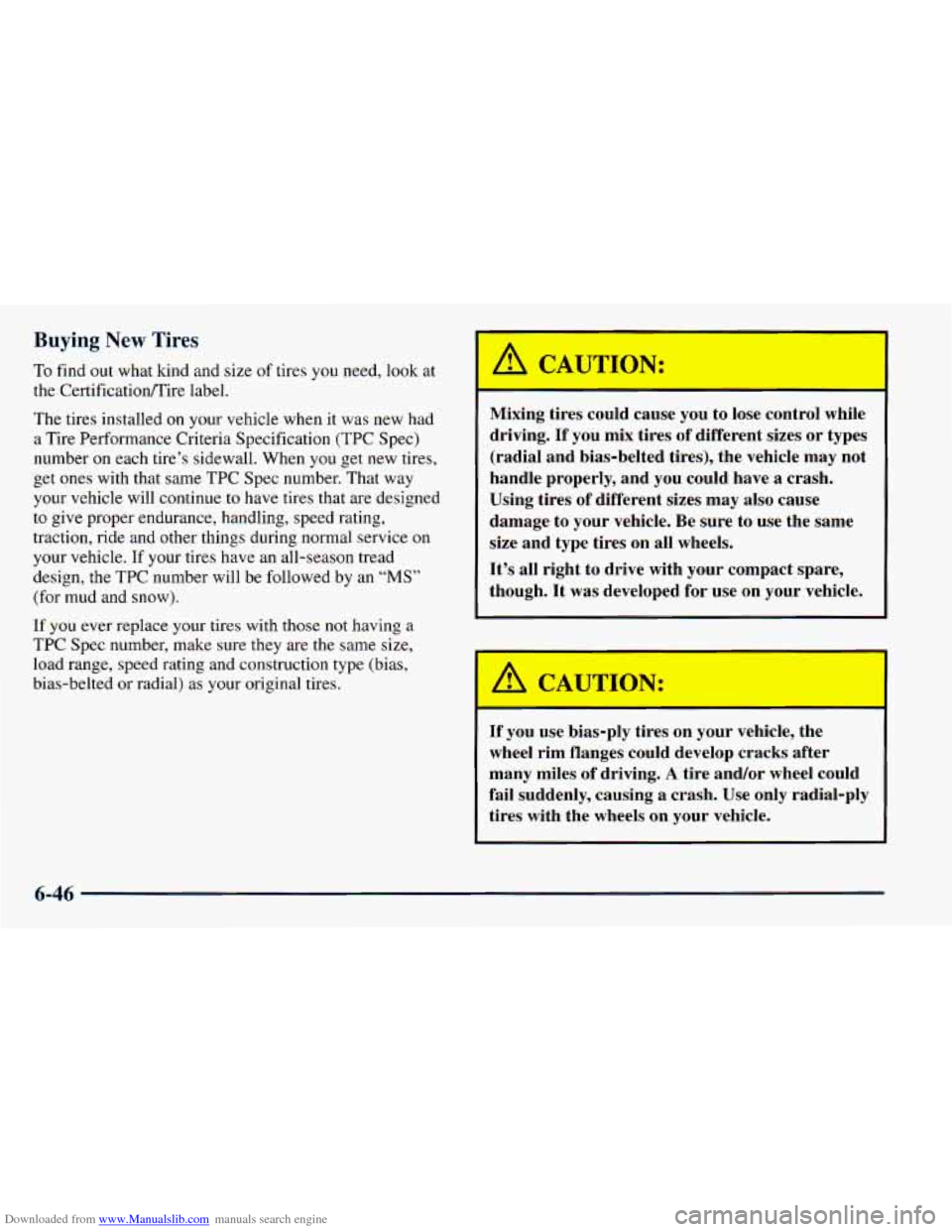
Downloaded from www.Manualslib.com manuals search engine Buying New Tires
To find out what kind and size of tires you need, look at
the CertificationRire label.
The tires installed on your vehicle when it was new had
a Tire Performance Criteria Specification (TPC Spec)
number on each tire’s sidewall. When you get new tires,
get ones with that same
TPC Spec number. That way
your vehicle will continue
to have tires that are designed
to give proper endurance, handling, speed rating,
traction, ride and other things during normal service on
your vehicle.
If your tires have an all-season tread
design, the TPC number will be followed by an
“MS”
(for mud and snow).
If you ever replace your tires with those not having a
TPC Spec number, make sure
they are the same size,
load range, speed rating and construction type (bias,
bias-belted or radial) as your original tires.
I A CAUTION:
---
Mixing tires could cause you to lose contrc while
driving.
If you mix tires of different sizes or types
(radial and bias-belted tires), the vehicle may not
handle properly, and you could have
a crash.
Using tires of different sizes may also cause
damage to your vehicle. Be sure to use the same
size and type tires on all wheels.
It’s all right to drive with your compact spare,
though. It was developed for use
on your vehicle.
If you use bias-ply tires on your vehil , the
wheel rim flanges could develop cracks after
many miles of driving.
A tire and/or wheel could
fail suddenly, causing
a crash. Use only radial-ply
tires with the wheels on your vehicle.
6-46
Page 309 of 414
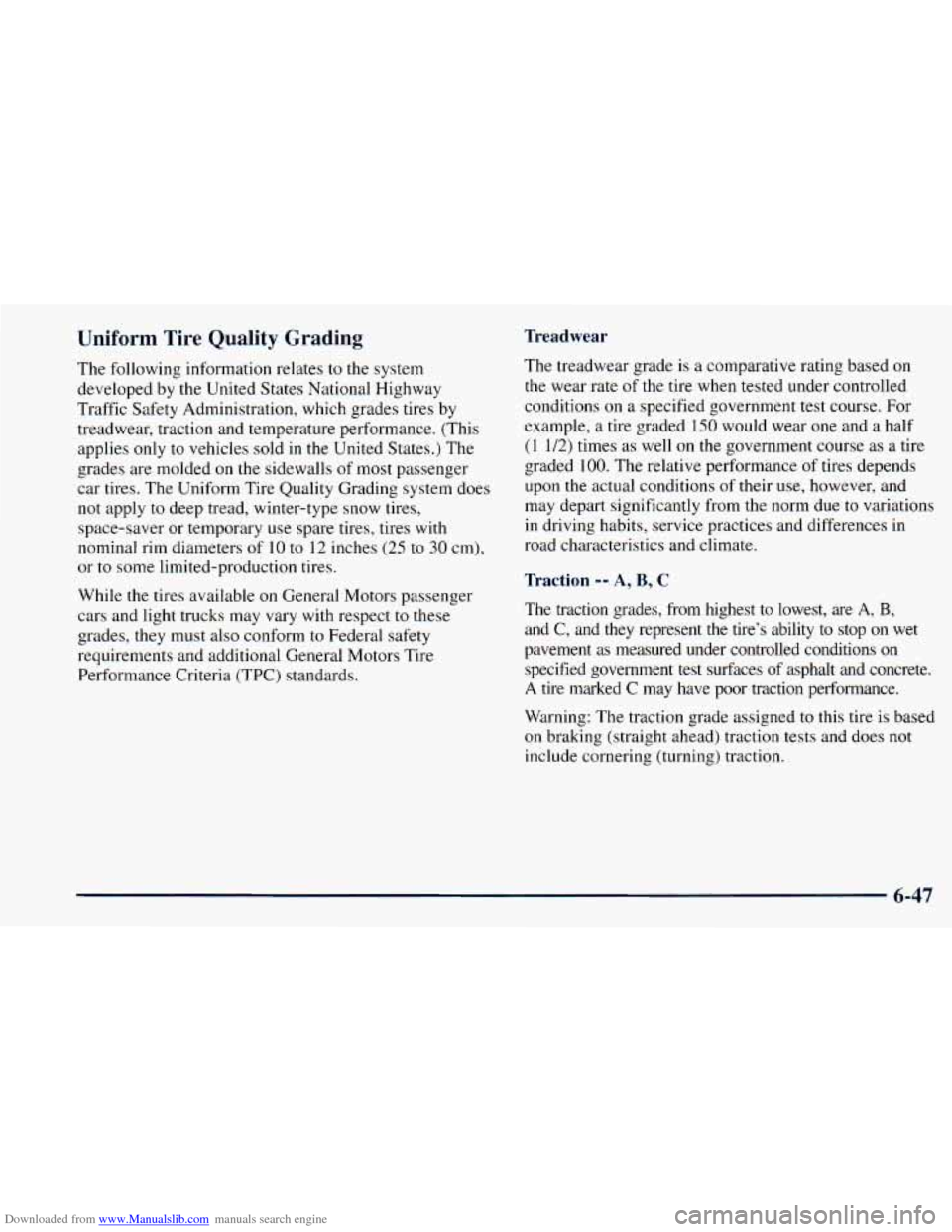
Downloaded from www.Manualslib.com manuals search engine Uniform Tire Quality Grading Treadwe:
The following information relates to the system
developed by the United States National Highway
Traffic Safety Administration, which grades tires by
treadwear, traction and temperature performance. (This
applies only to vehicles sold in the United States.) The
grades are molded
on the sidewalls of most passenger
car tires. The Uniform Tire Quality Grading system does
not apply to deep tread, winter-type snow tires,
space-saver or temporary use spare tires, tires with
nominal rim diameters of 10 to
12 inches (25 to 30 cm),
or
to some limited-production tires.
While the tires available on General Motors passenger
cars and light trucks may vary with respect
to these
grades, they must also conform to Federal safety
requirements and additional General Motors Tire
Performance Criteria (TPC) standards.
The treadwear grade is a comparative rating based on
the wear rate of the tire when tested under controlled
conditions
on a specified government test course. For
example, a tire graded 150 would wear one and
a half
(1 1/2) times as well on the government course as a tire
graded
100. The relative performance of tires depends
upon the actual conditions
of their use, however, and
may depart significantly from the norm due to variations
in driving habits, service practices and differences in
road characteristics and climate.
Traction -- A, B, C
The traction grades, from highest to lowest, are A, B,
and C, and they represent the tire’s ability to stop on wet
pavement as measured under controlled conditions
on
specified government test surfaces of asphalt and concrete.
A
tire marked C may have poor traction performance.
Warning: The traction grade assigned
to this tire is based
on braking (straight ahead) traction tests and does not
include cornering (turning) traction.
- 6-47
Page 390 of 414
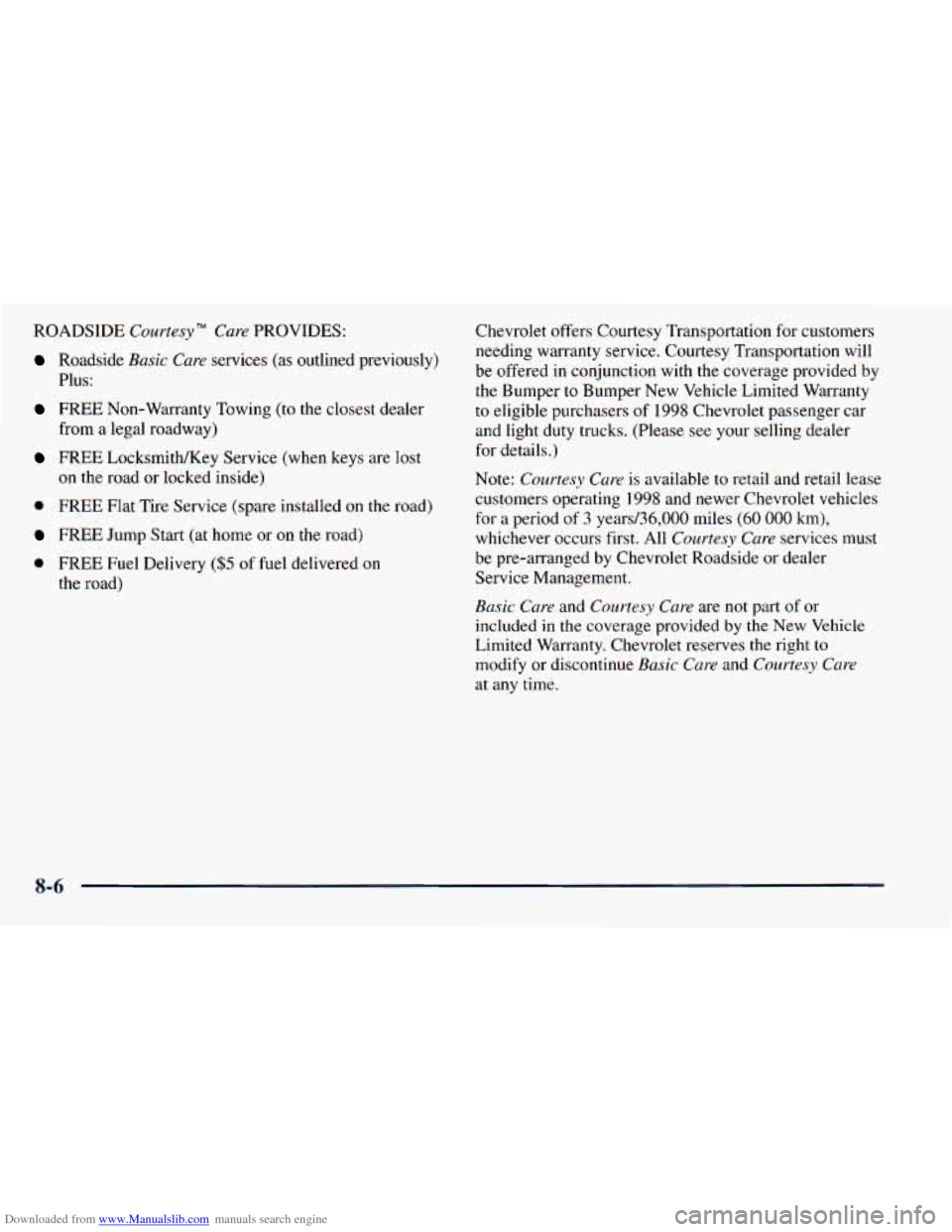
Downloaded from www.Manualslib.com manuals search engine ROADSIDE Courtesy TM Care PROVIDES:
Roadside Basic Care services (as outlined previously)
Plus:
FREE Non-Warranty Towing (to the closest dealer
from a legal roadway)
FREE Locksmith/Key Service (when keys are lost
0 FREE Flat Tire Service (spare installed on the road)
on
the road or locked inside)
FREE Jump Start (at home or on the road)
0 FREE Fuel Delivery ($5 of fuel delivered on
the road) Chevrolet offers Courtesy Transportation
for customers
needing warranty service. Courtesy Transportation will
be offered in conjunction with the coverage provided by the Bumper
to Bumper New Vehicle Limited Warranty
to eligible purchasers of 1998 Chevrolet passenger car
and light duty trucks. (Please see your selling dealer
for details.)
Note:
Courtesy Care is available to retail and retail lease
customers operating 1998 and newer Chevrolet vehicles
for a period
of 3 years/36,000 miles (60 000 km),
whichever occurs first. All
Courtesy Care services must
be pre-arranged by Chevrolet Roadside or dealer
Service Management.
Basic Care and Courtesy Care are not part of or
included
in the coverage provided by the New Vehicle
Limited Warranty. Chevrolet reserves the right to
modify or discontinue
Basic Care and Courtesy Care
at any time.
8-6
Page 400 of 414
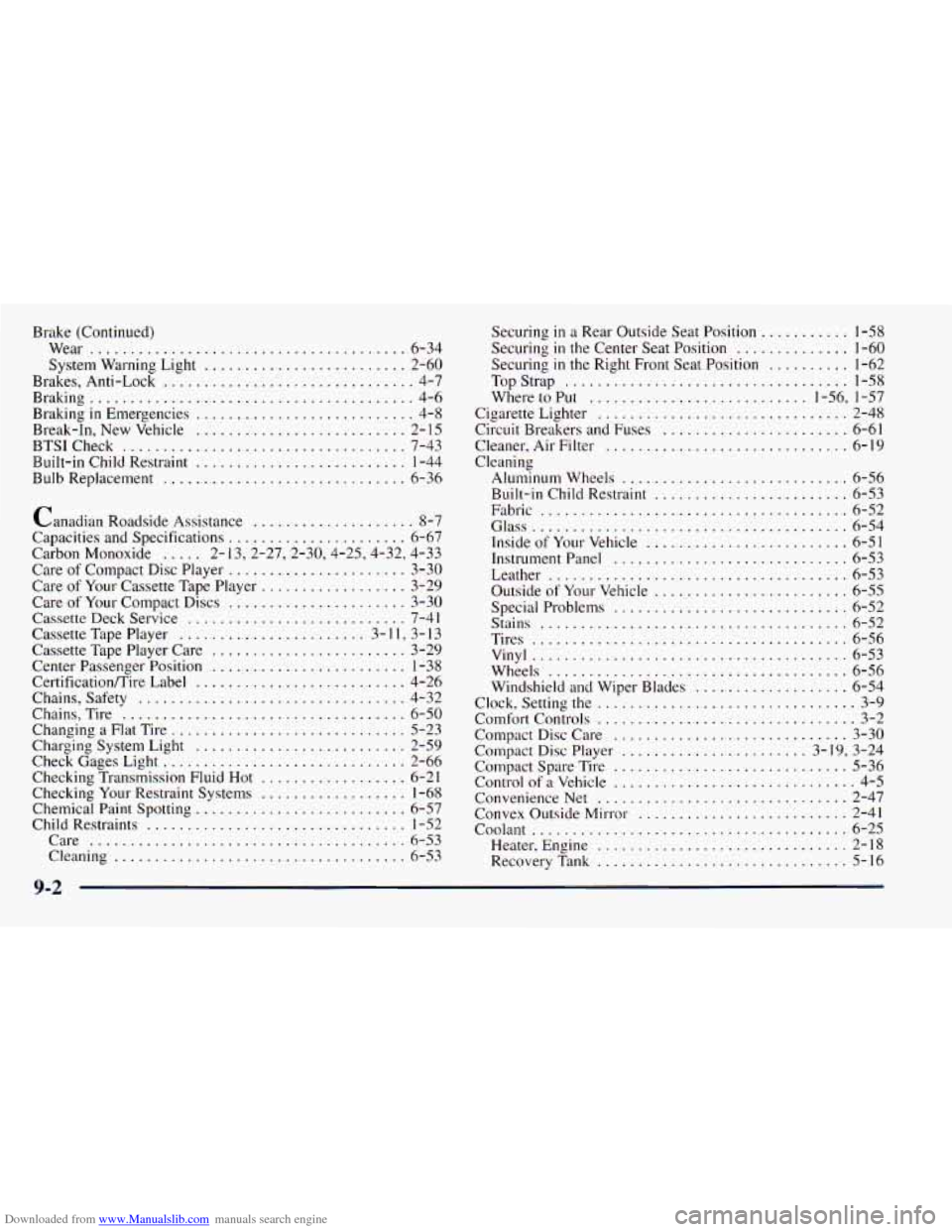
Downloaded from www.Manualslib.com manuals search engine Brake (Continued)
Wear
..................................
Brakes. Anti-Lock .........................
Braking ..................................
Braking in Emergencies .....................
Break-In. New Vehicle .....................
BTSI Check ..............................
Built-in Child Restraint .....................
Bulb Replacement ........................
System Warning Light ....................
Canadian Roadside Assistance ..............
Capacities and Specifications .................
Carbon Monoxide ..... 2- 13.2.27.2.30.4.25.
Care
of Compact Disc Player .................
Care of Your Cassette Tape Player .............
Care of Your Compact Discs .................
Cassette Deck Service ......................
Cassette Tape Player .......................
Cassette Tape Player Care ...................
Center Passenger Position ...................
Certification/Tire Label .....................
Chains. Safety ............................
Chains. Tire ..............................
Changing a Flat Tire ........................
Charging System Light .....................
Check Gages Light .........................
Checking Transmission Fluid Hot .............
Checking Your Restraint Systems .............
Chemical Paint Spotting .....................
Child Restraints ...........................
Care ..................................
Cleaning ...............................
9-2
..... 6-34
..... 2-60
...... 4-7
...... 4-6
...... 4-8
..... 2-15
..... 7-43
..... 1-44
.... 6-36
...... 8-7
..... 6-67
4.32. 4.33
..... 3-30
..... 3-29
..... 3-30
..... 7-41
3-1 1. 3.13
..... 3-29
..... 1-38
..... 4-26
..... 4-32
..... 6-50
..... 5-23
..... 2-59
..... 2-66
..... 6-21
..... 1-68
..... 6-57
..... 1-52
..... 6-53
..... 6-53 Securing
in a Rear
Outside Seat Position ........... 1-58
Securing in the Center Seat Position .............. 1-60
Securing
in the Right Front Seat Position .......... 1-62
TopStrap
................................... 1-58
Where to Put ........................... 1-56. 1-57
Cigarette Lighter ............................... 2-48
Circuit Breakers and Fuses
....................... 6-61
Cleaner.
Air Filter .............................. 6-19
Cleaning
Aluminum Wheels ............................ 6-56
Built-in Child Restraint ........................ 6-53
Fabric
...................................... 6-52
Glass ....................................... 6-54
Inside
of Your Vehicle ......................... 6-51
Instrument Panel
............................. 6-53
Leather
..................................... 6-53
Outside of Your Vehicle
........................ 6-55
Stains ...................................... 6-52
Tires
....................................... 6-56
Wheels
..................................... 6-56
Windshield and Wiper Blades
................... 6-54
Clock. Setting the
................................ 3-9
Comfort Controls
................................ 3-2
Compact Disc Care
............................. 3-30
Compact Disc Player
....................... 3-19. 3-24
Compact Spare Tire
............................. 5-36
Control
of a Vehicle .............................. 4-5
ConvenienceNet
............................... 2-47
Convex Outside Mirror
.......................... 2-41
Coolant
....................................... 6-25
Heater. Engine
............................... 2-18
Recovery Tank ............................... 5-16
Special Problems
................. ....... 6-52
Vinyl ....................................... 6-53